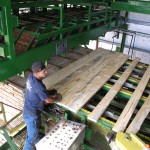In Lean Times, Lumber Companies Look Abroad
Lately, StateImpact has reported a series of stories on the timber industry. We’ve reported on a Montana entrepreneur’s effort to start up a small mill in Emmett, Idaho with the help of federal stimulus funding. We’ve also considered the divergent economic realities of counties associated with agriculture and counties associated with the timber industry. Next up: timber exports.
In the pre-recession years, before the housing boom busted, relatively little U.S. lumber went overseas. There was robust demand at home, and prices were good. There was no reason to undertake the effort (or the shipping cost) of sending lumber abroad.
The recession changed that.
From 2005 to 2009, the price of lumber fell from $387 per thousand board feet to $222. Production fell from 19 to 10 billion board feet. “This is the deepest, longest slump in the North American softwood lumber market,” says Pete Malliris, an associate editor with trade publication Random Lengths.
And since it began, exports have ballooned, as shown in the graph above.
Facing stagnant demand, U.S. lumber companies scrambled to find other markets. Tomorrow, we’ll air a broadcast story on one such company, Idaho Forest Group, the state’s largest lumber producer.
In general, the headline of the spike in exports has been sales to China. In 2011, China overtook Canada as the main destination for U.S. softwood lumber exports. “China was looking for fiber wherever they could get it,” Malliris explains.
But we’re already beginning to see these trends start to reverse. So far this year, the price of lumber stands at $308 per thousand board feet, its highest level since 2006. Shipments to China — a very price-sensitive market — are off by 30 percent.
Historically, Malliris says, exports have been cyclical. There are up-cycles and down-cycles. But this time around, it could be different. Lumber companies could be reluctant to give up overseas buyers as the U.S. housing market improves.
“What producers seem to want more than they did before are options,” Malliris observes. In other words, having just experienced an unprecedented contraction in domestic lumber demand, U.S. lumber producers see that selling in multiple markets gives them greater security and opportunity.
“They’re paying attention to what’s happening in Russia and what’s going on with the debt crisis in Europe, and how what happens with producers in those regions might affect their market position,” Malliris says. “They’re paying more and more attention to it.”
